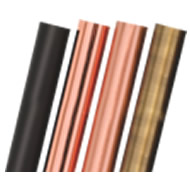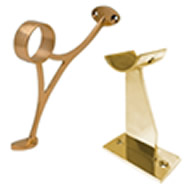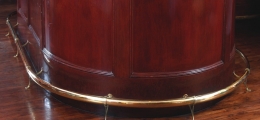Food shields and sneeze guards may seem like a minor part of your business, but choosing a proper food shield can impact customer confidence and food-safety conditions. Managers need to be aware of when it’s time to replace your food shields and sneeze guards, your options for replacement, your preferred installation method and how to set a maintenance plan. Following these steps will ensure that you are meeting safety and health standards and effectively utilizing your food shields.
A cheap sneeze guard assembled with nuts and screws won’t last as long as a solid, all-welded food shield unit — costing your company more in the long run.
When to Replace Food Shields
Food shields have either glass or clear acrylic between the customer and food, so it’s important to know when these shields need to be replaced. There are a wide variety of styles that managers can choose from including custom, decorative, adjustable or institutional designs. The most common type of food shields are pass-over units that are used in buffets. When properly maintained, food guards can last for around ten years. The most important function of food shields is to protect the food from being contaminated by customers, so it’s important to replace them when they start becoming less effective.
Any damage like cracking warrants replacement to protect both the food and customers. Any cracks will compromise the shield’s ability to prevent fluids from reaching the food it intends to protect. Managers need to closely monitor scratches and wear on tear. Glass alternatives often become cloudy with age, and if the surface is too scratched-up they can become unusable. Additionally, you should replace food shields when your menu or food service design is modified. Different foods require different temperature controls, and the room’s lighting can impact the effectiveness of the shield.
Options for Replacing Food Shields
When you do decide that it’s time to replace your food shield or sneeze guard, you’ll need to consider the design, application, support posts, clearance and installation of your replacement guard. There’s a large variety of styles, colors and features that should be considered along with the application of the food shield. Some fabricators, like ESP Metal Products & Crafts, can fabricate custom food shields in a wide variety of finishes and colors including polished brass, satin stainless steel, oil rubbed bronze as well as many other custom finishes and powder coat colors. Coated polished brass is a good option because it can prevent scratches and surface damage due to regular wear and tear making them much more durable. When replacing your food shields, you may want to consider having them configured with heat lamps or LED lighting. Food shields can also be customized with your company’s logo etched into its glass panels.
While finding a proper replacement, you’ll have to make certain that your food shield is appropriately supported. Heavy glass requires more support, while tempered glass will often shift under its own weight. This important consideration can save you from food shields that start bowing or sagging in the future. The installation of food guards is crucial, because they need to be secured in a way that is both structurally sound and aesthetically pleasing for customers. Also, make sure you understand the legal clearance guidelines set by the National Sanitation Foundation your installed food shield units are compliant. A cheap sneeze guard assembled with nuts and screws won’t last as long as a solid, all-welded food shield unit — costing your company more in the long run. These assembled units will require more maintenance, and general need to be replaced more often than all-welded food shield units.
Self-Installation vs. Professional Installation
Once you’ve purchased your food shield or sneeze guard, it will need to be properly installed. The greatest advantage of hiring a professional to install your shield is the confidence that the shield is installed correctly. Nearly all professional services guarantee that the installation will satisfy all safety requirements. If your goal is cost-effectiveness, then it may be smarter to self-install your food shield. You’ll save money and time choosing to do it yourself. If your counter configuration is unique, and has a variety of lengths or non-traditional angles, it may be wiser to hire a professional fabricator and installer. A professional fabrication and installation will ensure that the food shield units all fit together precisely with your counters or serving stations.
Food Shield Maintenance
While food shields and sneeze guards don’t require a whole lot of maintenance, it’s still necessary to routinely clean and inspect them. Never clean your food shield with cleaning pads, abrasive cleaners or chemicals. It’s safer to utilize a mild soap and water solution or a food-safe glass cleaner. You should wipe down the food guards at least daily. It’s also important to schedule a routine inspection to check your food shields for cracks, scratches, wear and tear and any other signs that indicate the guard is compromised. During these inspections, it may be necessary to tighten brackets or readjust tilting food guards occasionally. Some more-durable options, like those available at ESP Metal Products & Crafts, can be purchased entirely welded with no screws to maintain. They can handle a lot of wear and tear without needing to replace them. It takes minimal effort to take care of your food shields, but it can be extremely costly to overlook routine maintenance, inspection and cleaning.
When considering your options for an appropriate food shield, durability is one of the most important qualities to look for. It’s important to know when it’s time to replace your food guards, your options for replacement, your preferred installation method and how to set a maintenance plan.
TAGS: food shields & sneeze guards, safety, maintenance, restaurants, pizzeria, hotels




















